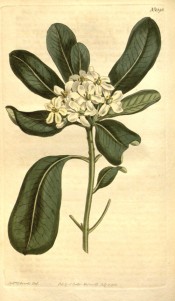Pittosporum tobira Dryand.
Half hardy, dense, rounded shrub or small tree with alternate, obovate leaves, to 10cm long, and large, terminal, umbel-like clusters of very scented, creamy white flowers, to 2.5cm across, in spring and summer, followed by yellow-brown capsules. To 10m. [RHSE, Hortus].
Horticultural & Botanical History
‘A large handrome shrub with very glossy foliage and white flowers, which change yellow as they fade. These are fragrant but the smell of the bruised leaves or bark is very disagreeable, and their taste nauseous, exactly resembling fagapenum, according to Kaempfer.
We have not seen the ripe fruit; but in its immature state it is obtusely three- rarely four-cornered; and a transverse section shows the future valves fleshy, convex, and forming as many receptacles of the seeds. There appears however to be only one loculament. Kaempfer describes the seeds as being angular from pressure, and only three in number, but in his figure they appear to be many, which corresponds better with the state of the unripe fruit. Except the one above quoted, we do not know that there has been any representation of this plant published.
Native of Japan and China. A rather hardy greenhouse shrub. Propagated by cuttings. Introduced to Kew Garden in 1804 by the Directors of the East-India Company, in the ‘Henry Addington’, Capt. Kirkpatrick. Flowers most part of the summer. Communicated by Messrs. Malcolm and Sweet, Nursery-men, from their very interesting collection at Stockwell-Common.’ [BM t.1396/1811].
History at Camden Park
Listed only in the 1857 catalogue [T.762/1857].
Notes
Used extensively in southern Europe for hedging. Drought resistant. [Hilliers’].
Published Mar 25, 2010 - 01:04 PM | Last updated Mar 25, 2010 - 01:10 PM
| Family | Pittosporaceae |
|---|---|
| Category | |
| Region of origin | China, Korea, Japan |
| Synonyms |
|
| Common Name | Japanese mock orange |
| Name in the Camden Park Record |
Pittosporum Tobira |
| Confidence level | high |
